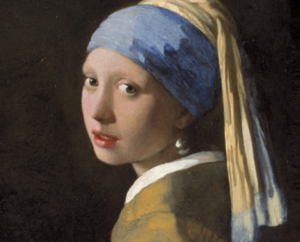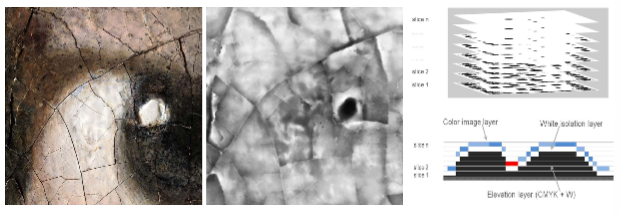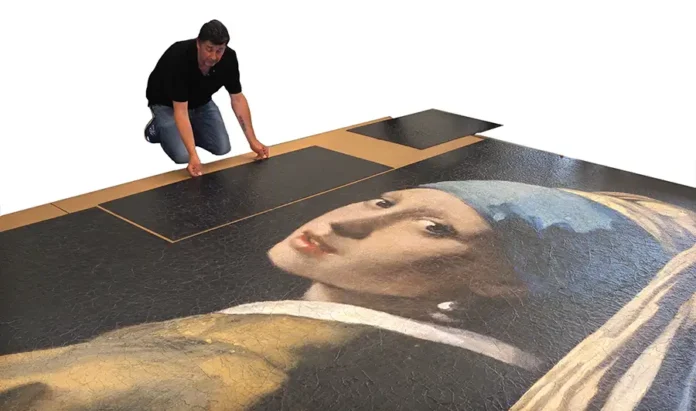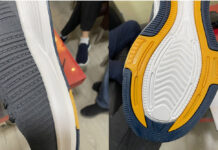By Liz Stevens, writer, UV+EB Technology
Girl with a Pearl Earring, the painting made by Dutch painter Johannes Vermeer in 1665, is a treasured artwork in the possession of the Mauritshuis Museum, The Hague, Netherlands. The painting, while known the world over, remains a mystery in many respects, even hundreds of years after its creation. In one of the Mauritshuis Museum’s recent research projects into the painting, restorer and project lead Abbie Vandivere aimed to learn more about the painting’s creation techniques, to uncover the ingredients used for its paint pigments and to assess how the painting may have changed during its 350+-year lifespan.
Deciphering the Past
 For this research project, the painting was scanned in microscopic ultra-fine detail by scanning expert Hirox-Europe. The result: a 10-billion-pixel 3D digital scan of the painting. Researchers at Technical University Delft used the digital scan to investigate the artwork in minute detail, tracing the pigments used to impart its colors and zeroing in on the tiniest details of Vermeer’s masterpiece.
For this research project, the painting was scanned in microscopic ultra-fine detail by scanning expert Hirox-Europe. The result: a 10-billion-pixel 3D digital scan of the painting. Researchers at Technical University Delft used the digital scan to investigate the artwork in minute detail, tracing the pigments used to impart its colors and zeroing in on the tiniest details of Vermeer’s masterpiece.
For the museum’s presentation of these new insights, Canon Production Printing, Venlo, Netherlands, took on the task of producing faithfully textured prints of the painting. Clemens Weijkamp, domain architect at Canon R&D, led the project, which tapped Canon’s Arizona series of flatbed printers, the company’s UV-curable inks and Canon’s PRISMAelevate XL software.
The incredibly detailed, hugely enlarged prints of the artwork include the complete painting rendered as a 4- x 3-meter print and several 1- x 1-meter enlargements of particular details of the artwork. The 3D-elevated prints, with layers of ink up to 8 mm, reflect the actual topography of the painting, including the height of paint layers, the shape of brush strokes and the artwork’s crackled top layer of varnish.
Enlarging a Masterpiece
A first step in producing the prints for the museum’s research presentation was proofing the colors. Research showed that the colors had changed in the 3.5 centuries since the painting has been exposed to the environment. Eleven samples from different areas of the painting were created, and each sample was prepped with 11 different color settings. The samples were sent to the Museum for its decision on which color settings most likely would match the colors Vermeer had used as he painted.
Canon’s PRISMAelevate XL elevated printing technology and software were used to prepare the image for printing with the Arizona line of Canon’s flatbed printers, which use LED-curable UV inks. PRISMAelevate XL software includes a Windows/Mac application that can be used as an extension in Adobe Photoshop and Illustrator. The software allows users to design and define their preference of elevations for an image. Alternatively, the topology of the print can match the actual height map of an object – as was the case with mapping a print to the Hirox-Europe 3D scan of Vermeer’s painting. The PRISMAelevate XL software output .pdf files that contained a height map file in grayscale (wherein black represents the highest elevation and white represents no elevation) and a file in full color.

The .pdf files were imported into the Canon ALPS application for Onyx Thrive raster imaging, which generates many layers/slices (up to 100) of printing information for the entire job. Canon’s Arizona 13xx and 23xx series of printers can produce elevated prints and automatically can process an entire unattended batch job. These two series of printers feature special print modes to ensure high reliability and equally high accuracy for printing many elevated layers in precise registration.
For elevated printing, Canon’s Arizona IJC357 and IJC358 inks were used. Very thin layers of ink were printed on top of each other, in layers of CMYK+white at 4 to 50 µm thick. The ink was cured after the application of each layer. Once the relief layers were completely built up, a top layer of white was applied and then the final full-color layer was added. According to Weijkamp, UV-curable ink – like the Arizona inks, which contain acrylates, photoinitiators and pigments – are the only type of ink that can produce elevated prints in a feasible, efficient manner.
For the print of Vermeer’s masterpiece, the team divided the image into 12 panels to be printed separately and then assembled the panels into the 4- x 3-meter finished print. The resulting presentation, “Who’s That Girl?” was exhibited at the Mauritshuis Museum to the delight of visitors who could touch the gigantic reproduction of Girl with a Pearl Earring and feel the actual buildup of paint and varnish that exists on the painting. Due to the success of the exhibition, it has been extended to the end of 2024.
Produced in conjunction with the exhibition is a 108-gigapixel interactive display of Girl with a Pearl Earring, which can be experienced online at https://www.hirox-europe.com/gigapixel/girl-with-a-pearl-earring/. For more information on Canon’s PRISMAelevate XL and the Arizona printer series, visit www.cpp.canon and https://graphiplaza.cpp.canon/software/prismaelevatexl/.







